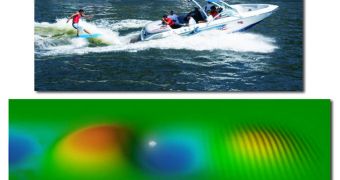Over the past 20 years or so, a multitude of massive particle accelerators have been built, culminating with the Large Hadron Collider's 27-kilometer-long tunnels. But the future of particle physics is on the tabletop, not deep underground, say researchers in the United States.
Machines like the LHC are becoming obsolete not because they use outdated technology or because they don't return scientific results. On the contrary, they meet both these criteria with great success.
Their problem is the price tag, and the time it take to complete one. Experts with the US Department of Energy's (DOE) Lawrence Berkeley National Laboratory (Berkeley Lab) have an alternative proposal.
They say that high-energy machines may be equally successful in achieving their goals if they are miniaturized down to tabletop size. The team has already set out to put its idea into practice.
Experts are currently developing BELLA (Berkeley Lab Laser Accelerator), which is being assembled under the guise of the DOE LOASIS program. This new, remarkably-compact instrument is in fact a laser-plasma wakefield accelerator (LPWA).
Simulations have shown that a single, 1-meter-long stage in a BELLA-class device will be capable of accelerating an electron beam to energy levels reaching 10 billion electron volts (BeV).
Basic calculations show that this is 20 percent the energy level achievable with the SLAC National Accelerator Laboratory, which boasts a 2-mile linear tunnel, the Berkeley Lab team explains.
One thing hindering the development of LPWA is the incapacity of supercomputers to simulate exactly what would happen inside such a device in 3D. In a new research by Berkeley Lab experts, a new method of simulating collisions inside such accelerators has been developed.
Accelerator and Fusion Research Division (AFRD) scientist Jean-Luc Vay was the leader of the team that created the new approach, after getting inspiration from the famed physicist Albert Einstein.
A full 3D simulations of a single BELLA stage become available within a few hours of using this new, “boosted-frame” method, Vay says. These calculations are performed thousands of times faster than possible with the most advanced supercomputers today.
Full details of the findings are published in the March issue of the esteemed scientific journal Physics of Plasma Letters. Experts from the Denver-based Tech-X Corporation and the DOE Lawrence Livermore National Laboratory (LLNL) were also involved in the research.
“We produced the first full multidimensional simulation of the 10 billion-electron-volt design for BELLA. We even ran simulations all the way up to a trillion electron volts, which establishes our ability to model the behavior of laser-plasma wakefield accelerator stages at varying energies,” Vay says.
“With this calculation we achieved the theoretical maximum speedup of the boosted-frame method for such systems – a million times faster than similar calculations in the laboratory frame,” he concludes.

 14 DAY TRIAL //
14 DAY TRIAL //